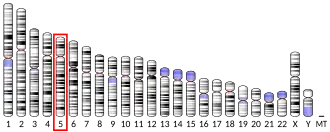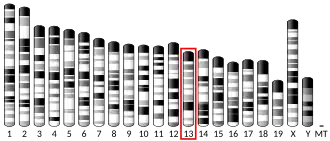Iroquois-class homeodomain protein IRX-2, also known as Iroquois homeobox protein 2, is a protein that in humans is encoded by the IRX2 gene.[5][6]
Function
IRX2 is a member of the Iroquois homeobox gene family. Members of this family appear to play multiple roles during pattern formation of vertebrate embryos.[5]
Cancer
IRX2 gene has been observed progressively downregulated in Human papillomavirus-positive neoplastic keratinocytes derived from uterine cervical preneoplastic lesions at different levels of malignancy. [7] For this reason, IRX2 is likely to be associated with tumorigenesis and may be a potential prognostic marker for uterine cervical preneoplastic lesions progression. [7]
References
- ^ a b c GRCh38: Ensembl release 89: ENSG00000170561 – Ensembl, May 2017
- ^ a b c GRCm38: Ensembl release 89: ENSMUSG00000001504 – Ensembl, May 2017
- ^ "Human PubMed Reference:". National Center for Biotechnology Information, U.S. National Library of Medicine.
- ^ "Mouse PubMed Reference:". National Center for Biotechnology Information, U.S. National Library of Medicine.
- ^ a b "Entrez Gene: iroquois homeobox 2".
- ^ Ogura K, Matsumoto K, Kuroiwa A, Isobe T, Otoguro T, Jurecic V, Baldini A, Matsuda Y, Ogura T (2001). "Cloning and chromosome mapping of human and chicken Iroquois (IRX) genes". Cytogenet. Cell Genet. 92 (3–4): 320–5. doi:10.1159/000056921. PMID 11435706. S2CID 46509502.
- ^ a b Rotondo JC, Bosi S, Bassi C, Ferracin M, Lanza G, Gafà R, Magri E, Selvatici R, Torresani S, Marci R, Garutti P, Negrini M, Tognon M, Martini F (April 2015). "Gene expression changes in progression of cervical neoplasia revealed by microarray analysis of cervical neoplastic keratinocytes". J Cell Physiol. 230 (4): 802–812. doi:10.1002/jcp.24808. hdl:11392/2066612. PMID 25205602. S2CID 24986454.
Further reading
- Lam CY, Tam PO, Fan DS, et al. (2008). "A genome-wide scan maps a novel high myopia locus to 5p15". Invest. Ophthalmol. Vis. Sci. 49 (9): 3768–78. doi:10.1167/iovs.07-1126. PMID 18421076.
- Cirulli ET, Kasperavičiūtė D, Attix DK, et al. (2010). "Common genetic variation and performance on standardized cognitive tests". European Journal of Human Genetics. 18 (7): 815–20. doi:10.1038/ejhg.2010.2. PMC 2987367. PMID 20125193.
- Adamowicz M, Radlwimmer B, Rieker RJ, et al. (2006). "Frequent amplifications and abundant expression of TRIO, NKD2, and IRX2 in soft tissue sarcomas". Genes Chromosomes Cancer. 45 (9): 829–38. doi:10.1002/gcc.20343. PMID 16752383. S2CID 24491021.
- Matsumoto K, Nishihara S, Kamimura M, et al. (2004). "The prepattern transcription factor Irx2, a target of the FGF8/MAP kinase cascade, is involved in cerebellum formation". Nat. Neurosci. 7 (6): 605–12. doi:10.1038/nn1249. PMID 15133517. S2CID 23807922.
- Bonaldo MF, Lennon G, Soares MB (1996). "Normalization and subtraction: two approaches to facilitate gene discovery". Genome Res. 6 (9): 791–806. doi:10.1101/gr.6.9.791. PMID 8889548.
- Lewis MT, Ross S, Strickland PA, et al. (1999). "Regulated expression patterns of IRX-2, an Iroquois-class homeobox gene, in the human breast". Cell Tissue Res. 296 (3): 549–54. doi:10.1007/s004410051316. PMID 10370142. S2CID 37046813.
- Strausberg RL, Feingold EA, Grouse LH, et al. (2002). "Generation and initial analysis of more than 15,000 full-length human and mouse cDNA sequences". Proc. Natl. Acad. Sci. U.S.A. 99 (26): 16899–903. Bibcode:2002PNAS...9916899M. doi:10.1073/pnas.242603899. PMC 139241. PMID 12477932.
This article incorporates text from the United States National Library of Medicine, which is in the public domain.
|
|---|
(1) Basic domains |
|---|
| (1.1) Basic leucine zipper (bZIP) | |
|---|
| (1.2) Basic helix-loop-helix (bHLH) | | Group A | |
|---|
| Group B | |
|---|
Group C
bHLH-PAS | |
|---|
| Group D | |
|---|
| Group E | |
|---|
Group F
bHLH-COE | |
|---|
|
|---|
| (1.3) bHLH-ZIP | |
|---|
| (1.4) NF-1 | |
|---|
| (1.5) RF-X | |
|---|
| (1.6) Basic helix-span-helix (bHSH) | |
|---|
|
|
(2) Zinc finger DNA-binding domains |
|---|
| (2.1) Nuclear receptor (Cys4) | | subfamily 1 | |
|---|
| subfamily 2 | |
|---|
| subfamily 3 | |
|---|
| subfamily 4 | |
|---|
| subfamily 5 | |
|---|
| subfamily 6 | |
|---|
| subfamily 0 | |
|---|
|
|---|
| (2.2) Other Cys4 | |
|---|
| (2.3) Cys2His2 | |
|---|
| (2.4) Cys6 | |
|---|
| (2.5) Alternating composition | |
|---|
| (2.6) WRKY | |
|---|
|
|
|
(4) β-Scaffold factors with minor groove contacts |
|---|
|
|
(0) Other transcription factors |
|---|
|
|
see also transcription factor/coregulator deficiencies |



